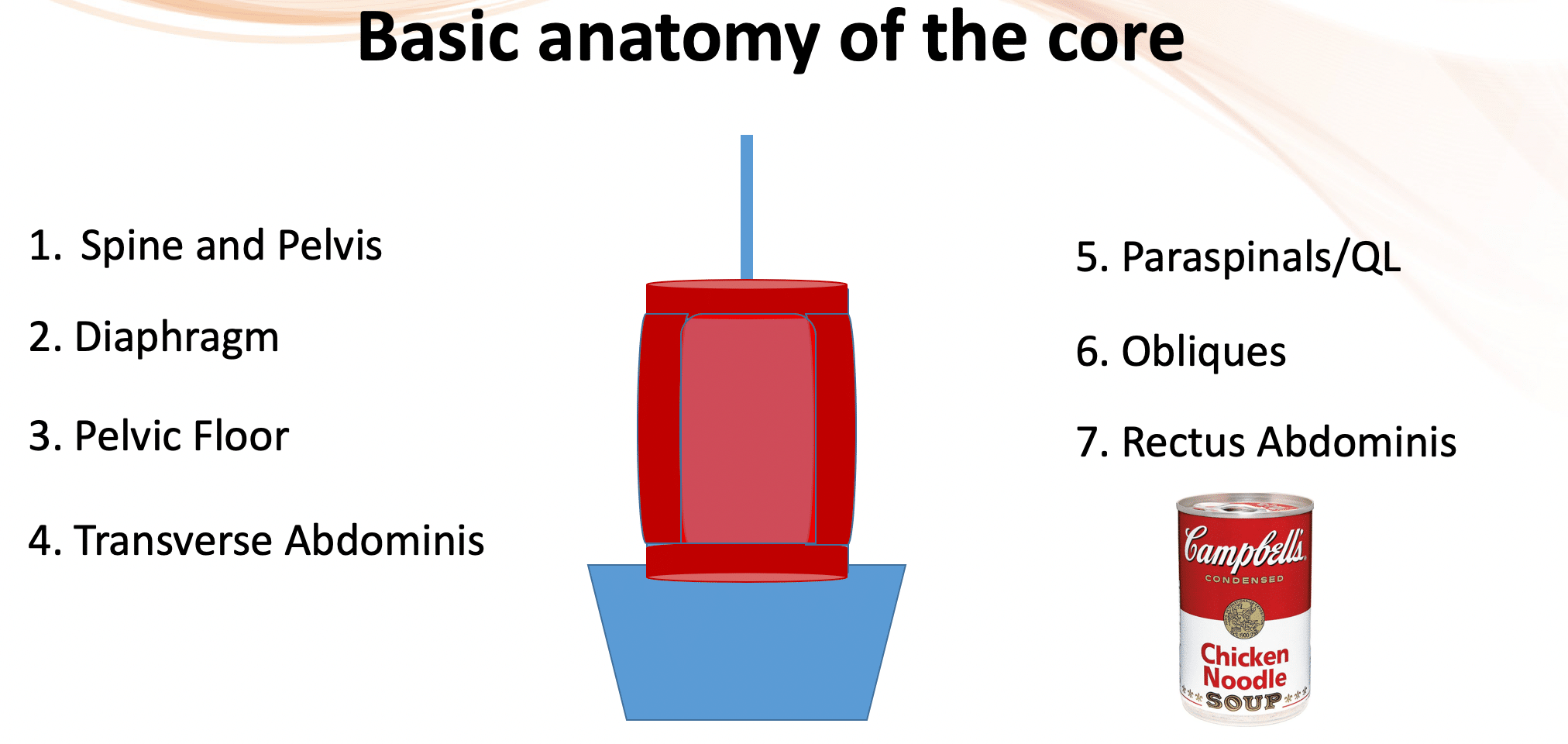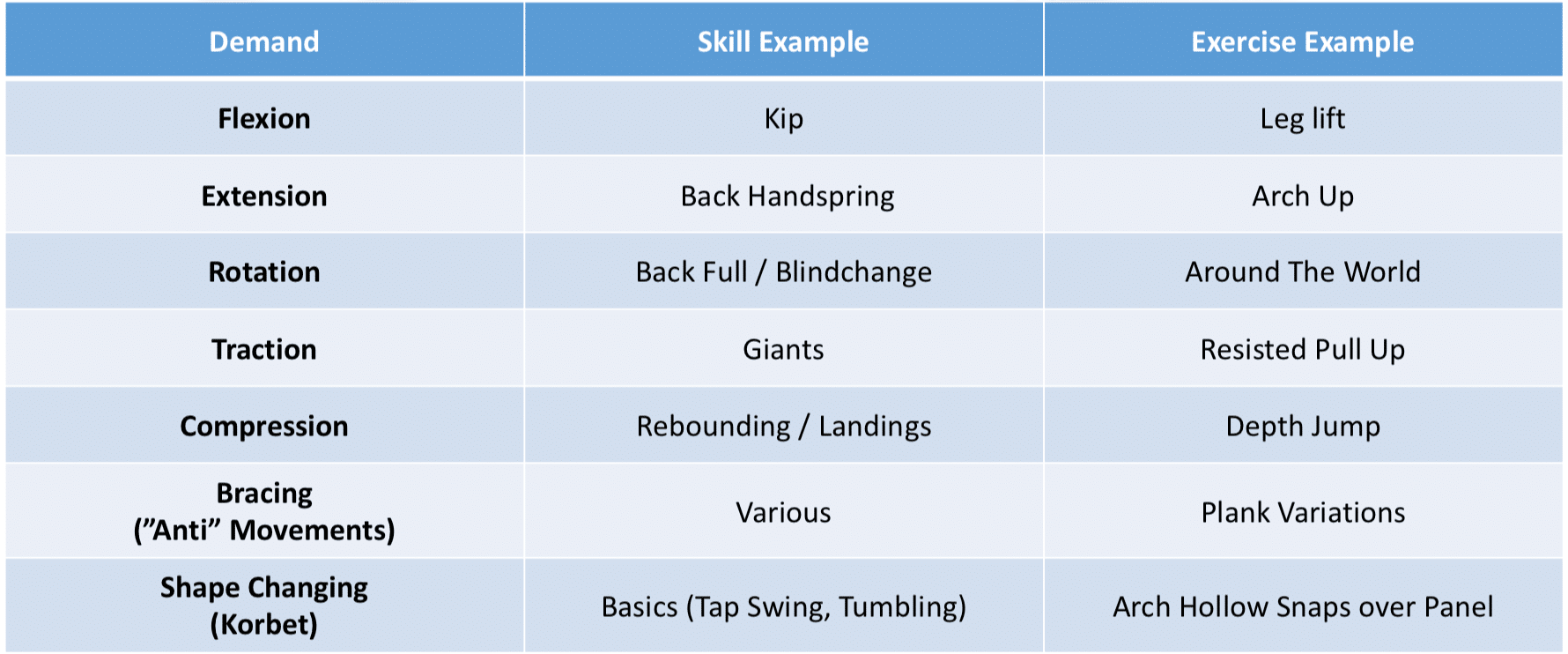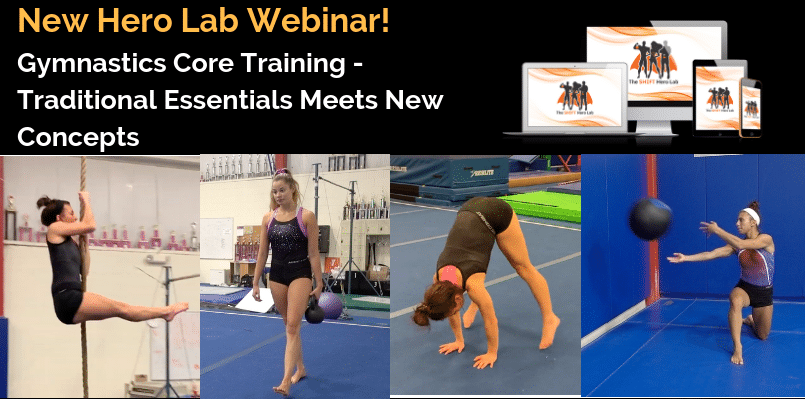Boost Gymnastics Core Strength with These 3 “Must Do” Things
A strong, stable core is one of the absolute “must haves” in gymnastics. One reason is performance-based, as different events and the skills within those events require massive amounts of core strength. Creating “stiffness” in body shapes to absorb force allows good punching, lines, and handstand fundamentals. It is also integrated during shape changes as seen with basic tap swings and tumbling. Lastly, a strong core allows for maximal force production to occur in the arms and legs, which is important for sprinting during vault, various leaps/jumps, and bar or ring events.

A second reason for developing core strength is more injury prevention related, as gymnastics places massive force on the spine of a gymnast. Peak vertical forces during simulated landing tasks reach up to 9x body weight in gymnastics (find a great research paper here), while maximal vertical forces during the take-off of a double back on the floor have been recorded at 6874 Newtons (reference here).
Spine injuries and back pain in gymnasts have been reported between 25% and 84% (more research within this journal volume here) and unfortunately are something that plague gymnasts during and after their competitive careers (more research here) causing limited skill progress and time away fromt training.

Given these concepts and more, most people know that core training is important. But, when it comes to designing and implementing strength programs they get massively overwhelmed.
This is understandable, and I was this way for many years. The combination of the mysterious “core” being confusing to wrap your head around, social media giving 100s of exercises, and us only having so much time/equipment during practice all combine to make people really frustrated.
Many people are left asking
- What exercises should I do?
- Should I do only gymnastics core exercises or other non-gymnastics ones I see online?
- Should we do skill based core or general core work?
- What if it’s too hard/too easy for my athletes?
- What if I don’t have the space and equipment during practice?
- How do I get them all in when I only have 30 minutes?
To help people clear up the murky water, here are 3 principles that I have found absolutely essential. Because they are more principle-based, and not “the best exercise”, they can be adapted to any situation, athlete level, or context. Knowing these has allowed me to create many different core training programs for both athletes I coach and athletes I treat for back injuries.
Table of Contents
1. You Must Understand Basic Core Function and Anatomy
You would never attempt to change the brakes on your car if you knew nothing about the wheels, brake pads, or axels. The same goes for core conditioning. You can’t hope to build a great core program if you don’t understand basic core function and anatomy, and then view them in the context of gymnastics demands.
I view the core as having three roles:
- Protect essential body parts by acting together as a “brace” – the core muscles all must work in coordination to keep vital areas safe, such as the spine, spinal cord, and organs. This also blends into assisting the lungs for breathing, which is also pretty important.
- Produce, transfer, and absorb force – This goes for both locally at the spine but also in conjunction with the upper/lower body. As mentioned above, crazy high forces go through the lower back during gymnastics. The core works to help not only create movement in skills, but also buffer these forces to support number 1 and move the body efficiently.
- Provide a stable base for the arms and legs – A cannon won’t shoot too far if it’s on a canoe in the middle of a lake. It needs a sturdy base like land to optimally produce force. The same goes for the legs/arms working off the base of a strong, stable core. It doesn’t matter how strong the arms and legs are if there is no stable base to work off of.
I have read a lot of spine injury research, as well as strength and conditioning textbooks, and from all of this, I like to picture the core as a “canister” of muscles surrounding the spine.

It has a larger outer layer with muscles like the obliques, rectus abdonimis, paraspinals, diaphragm, and pelvic floor. These work mostly under our control and can produce lots of power (we understand how to “flex our abs”). There is also a deeper layer full of very tiny muscles that only span 1 or 2 joints, that help automatically control these segments. These work more on autopilot (we can’t “flex our L2-L3 multifidi” as well) and require specific loads or movements to help recruit. Which leads to my next point.
2. Core Control and Core Strength
are Equally as Important
Unfortunately, just doing lots of legs lifts and planks won’t optimally prepare a gymnast for the high force demands of gymnastics. Nor will it help prevent back pain. If that were the case, the injury rate would be staggeringly low. Most gymnasts are building core training into their weekly training through drills, skills, and separate core strength circuits.
It’s not that those things aren’t important, they just won’t train everything needed for success. Core “control” is also absolutely essential for gymnasts alongside core strength. Just like anything else in gymnastics, it must be valued as part of training while being done with the correct focus and technique.
In my mind, 3 components of understanding alignment, knowing how to brace using the entire core, and knowing how to breathing during this process make up the foundation of core control.

Various drills can be used to teach this, and done in warm-ups, as side stations, and during prehab or lighter days. When you combine these control aspects with good technique and gymnastics specific movements like leg lifts, presses, and hollow / arch holds we start to be on the right track. Which leads to number 3.
3. Creating Movement and Resisting Movement are
Also Equally as Important For Core Strength
When creating core conditioning programs, we must understand that the gymnastics places a variety of demands on athletes. Here is a table I made that summarizes most in my mind, along with skill and exercise examples.

In order to prepare for this huge range of demands, programs must choose exercises that create movement (as is commonly seen in gymnastics specific conditioning with leg lifts, arch ups, or around the worlds) but also resist movement (as is commonly seen in gymnastics or regular fitness with planks, kettlebell carries, sled dragging).
This helps build a very robust core that can dynamically snap into shapes like during a double back, but also remain “stiff” under high forces occurring suddenly such as catching an overshoot handstand on bars. We must prepare athletes for both of these categories, and in a variety of motions. I made a huge mistake in not understanding how all aspects, including the diaphragm on top, pelvic floor, and transverse abdominal, needed to be trained in the gym.
Bonus – 4. You Must Train in 360 Degrees, Not Only “Show and Go”
6 Pack Muscles
As a bonus, I wanted to build all these points together to really drive home my main point. Although in gymnastics we do see lots of isolated skill based movements (compression during kips, tight arch setting for tumbling), no one core muscle is ever working by itself.
Even in specific skill circumstances the core is working as a unit to produce, transfer, and absorb force. This is definitely the case during shape changing where the shoulders and hips also help. This is also seen during punching on floor, hitting the springboard on vault, and under massive forces during dismounts or landings. However for most of gymnastics, the core is working as a unit as mentioned above.
Due to this, we have to make sure we program exercises that not only support gymnastics specific creation of shapes but also exercises that teach the athlete how to brace for stiffness while keeping proper breathing patterns.
The creation of shapes may include things like angled v ups
Want to Learn All The Core Strength Ideas, Exercises, and Programs
I Use With Gymnasts?
This small blog post is really just the tip of the iceberg. If you liked this, and want to learn exactly how I approach core training with all gymnasts, I have put together a brand new 1-hour lecture that covers all my current approaches.
You can view that lecture along with my full lectures on increasing shoulder/hip flexibility, building leg power, reducing overuse knee and ankle injuries, and more inside The Hero Lab. There is over 15 hours of gymnastics lecture content and guest interviews, and tons of downloadable worksheets to use in the gym.
Along with the lecture, you also get access to our incredible private discussion group full of international gymnastics professionals from over 15 countries. Click below to learn more!
I hope you have a great week!
– Dave
Dr. Dave Tilley DPT, SCS, CSCS
CEO/Founder of SHIFT Movement Science





